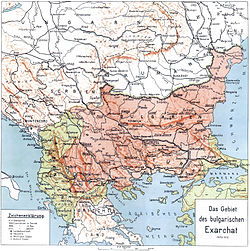Bulgarian irredentism
Appearance

Bulgarian irredentism is a term to identify the territory associated with a historical national state and a modern
nationalist movement in the 19th and 20th centuries, which would include most of Macedonia, Thrace and Moesia
.
History
The larger proposed Bulgarian state was suggested under the Treaty of San Stefano in 1878.
The issue of irredentism and nationalism gained greater prominence after the Treaty of San Stefano. It established a Principality of Bulgaria, with territory including most of
Eastern Thrace, and nearly all of Macedonia. This treaty laid grounds for much of the later claims for a Greater Bulgaria. However, the Treaty of San Stefano was a preliminary one, and the borders of the newly created Bulgaria were established in the Treaty of Berlin. It saw the previous territory divided in three – the Principality of Bulgaria, the autonomous province of Eastern Rumelia
, and Macedonia, which remained under Ottoman control.
In the early 20th century, control over Macedonia was a key point of contention between Ottoman Empire, Bulgaria,
Macedonian Campaign of World War I
(1915–1918).
Just before entering
Eastern Macedonia and parts of Western Thrace, as well as Yugoslav Macedonia (Vardar Macedonia).[2] With the exception of Southern Dobruja, these concessions were reversed with the Allied victory (i.e. at the Paris Peace Conference
of 1947).
Gallery
-
Bulgarian Exarchate (1870–1913).
-
Bulgaria according to the Constantinople Conference of 1876.
-
Treaty of San Stefano (1878) showing the boundaries of Bulgaria.
-
Bulgarian campaigns during World War I (1915-1918).
-
Bulgaria during World War II (1941-1944).
See also
- Bulgarian National Awakening
- Bulgarian Millet
- Bulgarian unification
- Bulgarian Declaration of Independence
References
- ^ "Bulgaria During World War II". Archived from the original on 2007-02-03. Retrieved 2007-02-12.
- ISBN 0804708703, p. 128.
External links
Wikimedia Commons has media related to Greater Bulgaria.





